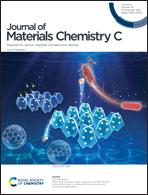Conductivity and memristive behavior of completely charged domain walls in reduced bidomain lithium niobate†
Abstract
Among many materials considered for use in domain-wall nanoelectronics, lithium niobate (LiNbO3, LN) represents one of the most technologically important and physically stable materials. Compared with many other reports where inclined domain walls are investigated, this study is focused on flat and almost completely charged domain walls (CDWs) of large area in undoped bidomain LN crystals heat-treated in a reducing atmosphere. It was revealed that the electrical conductivity of head-to-head CDWs in the reduced LN (RLN) is accessible without super-bandgap photoexcitation, shows memristive behavior and can be tuned by applying an external voltage, while tail-to-tail CDWs are insulating. The activation energy of polaron mobility as well as electron localization energy was estimated based on I–V curve measurements. The data obtained for the head-to-head CDWs in bidomain crystals show comparative or even higher local conductivity relative to inclined CDWs in LiNbO3:Mg as well as ion-sliced single-crystal LN films. Moreover, domain walls in bidomain crystals are highly reproducible, almost flat and possess maximum interface charge density which is promising for future mass production of CDW-based nano-electronic devices operating at the intersection of electronics, optics and mechanics.



 Please wait while we load your content...
Please wait while we load your content...